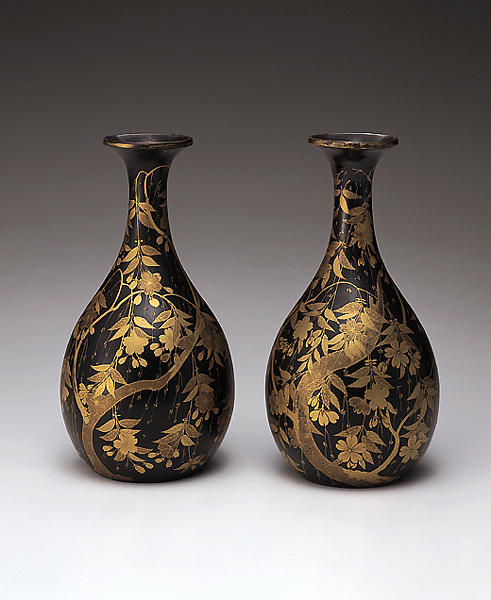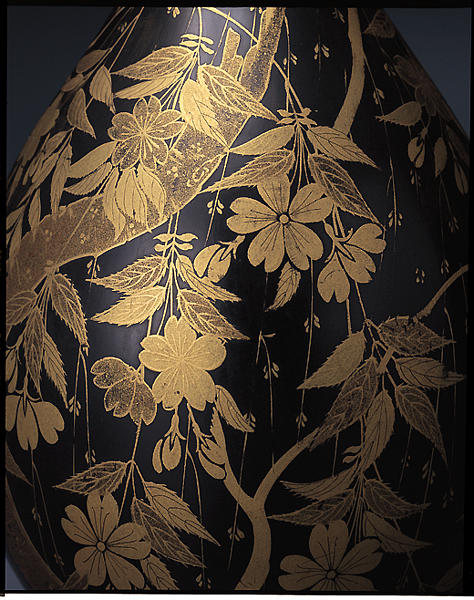枝垂桜蒔絵徳利
- 安土桃山時代
- 16世紀
- 木製漆塗蒔絵
- H-22.1 D-12
- 所蔵
- MIHO MUSEUM
蒔絵
蒔絵
日本の漆工芸を代表する加飾法で我が国独自に発展した。漆で文様を描き、乾かないうちに金銀などの金属粉を蒔きつけて文様を表す。起源は奈良時代に遡り、正倉院の金銀でん荘唐大刀の鞘に施された末金るの技法と考えられる。
塩屋千鳥蒔絵硯箱
浄土図蒔絵小箱
梅月文螺鈿蒔絵文台
雲錦蒔絵提重 伝 春正作
袋物蒔絵大鼓胴
藤蒔絵長持
秋草蒔絵沈箱
菊鶴亀蒔絵硯箱
蒔絵手拭掛
蒔絵角盥
亀甲文蒔絵香合(鏡箱)
桐蒔絵硯箱
籬菊蒔絵香合(鏡箱)
菊桐紋蒔絵盥
葡萄蒔絵水筒
桐巴紋枝垂桜蒔絵大棗
籬秋草桔梗紋散蒔絵厨子棚
雷雲蒔絵螺鈿鼓胴
Catalogue Entry
Momoyama period, 16th century
Height, 22.1cm; mouth diameter, 5.7cm;
torso diameter 12.1cm
A pair of relatively small tokkuri jars. Uniquely Momoyama characteristics can be seen in the mouth rim which spreads at its extreme edge and the swelling form of the torso. Coated overall in black lacquer. Each is decorated with a single weeping cherry tree. Typical Kodaiji makie lacquer techniques are used, such as the superb use of gold hiramakie with an enashiji patterning and hari-gaki (a needle is used to draw lines in a wet makie surface) lacquer drawing technique. A close examination of this pair of tokkuri reveals that one shows an old cherry tree, while the other shows a young cherry tree.
The use of this kind of elaborate makie decoration on eating and drinking utensils began in the Momoyama period. This embellishment reflects the open atmosphere of Japan's pre-modern era. AH
解説(春の玉手箱)
やや小振りの徳利の一対。口縁が極端に開き,胴の張った桃山時代独特の徳利の形である。
総体黒漆塗。ともに一樹の枝垂桜を意匠している。技法は典型的な高台寺蒔絵,金の平蒔絵で絵梨地と針描(蒔絵した面がまだ乾かないうちに針のようなもので引っ掻いて線をつくるもの)をうまく用いて描いている。また,この一対の徳利を細見すると,一方は老樹,他方は若樹という違いがあることは、陰陽道的な思想の影響も考えられなくはない。
また、徳利の美しい曲面と桜の枝ぶりとが調和し,蒔絵の煌きと相俟って不思議な奥行き間を現出させている。このように,飲食器に蒔絵を施して豪華に装飾したのは桃山時代から。近世という開かれた時代の反映である。

